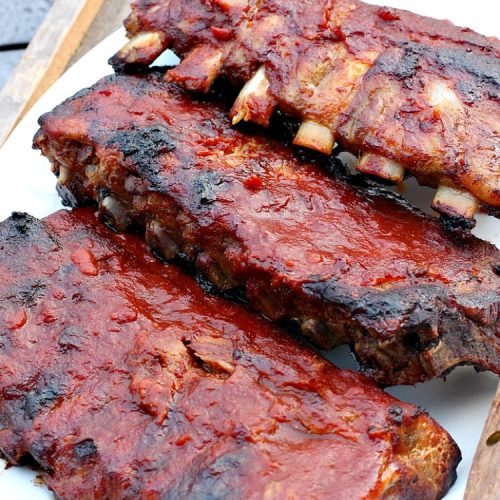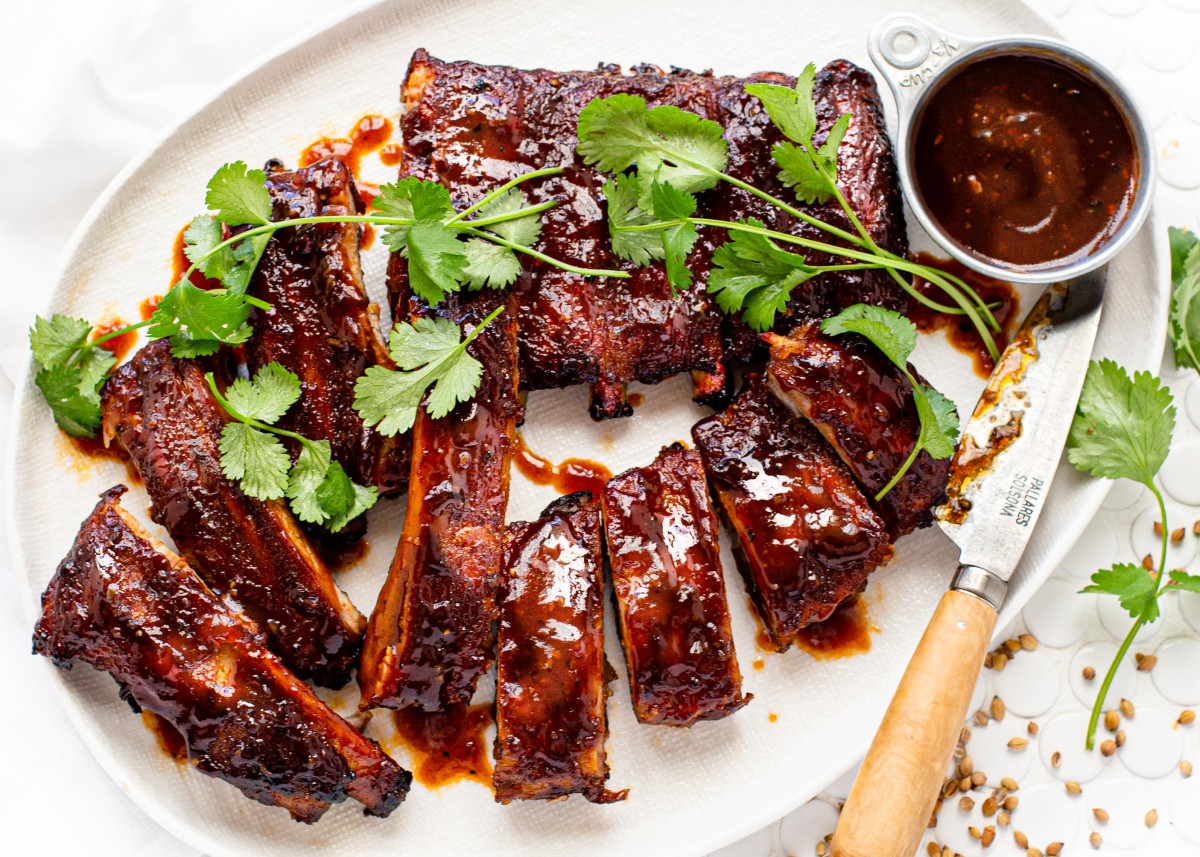Barbecue Ribs: A Quintessential American Classic
Barbecue ribs hold a special place in American cuisine, especially in the Southern and Midwestern regions where barbecue culture thrives. Juicy, tender, and bursting with flavor, barbecue ribs are one of the most iconic dishes when it comes to grilling and outdoor cooking. They are a true labor of love, with hours spent slow-cooking them to perfection. Whether it’s Memphis-style dry rub ribs or Kansas City-style ribs slathered in a sweet and tangy sauce, barbecue ribs have become a staple at backyard cookouts, family gatherings, and competitive barbecue events across the United States.
The History and Culture of Barbecue Ribs
The art of barbecuing ribs has deep roots in American history, particularly in the Southern United States, where smoking and slow-cooking meats is a time-honored tradition. Barbecue itself likely evolved from indigenous cooking techniques and was further influenced by African slaves who brought their own methods of smoking and slow-cooking meat to America. Over time, barbecuing became a part of Southern culinary heritage, with ribs being one of the most beloved cuts of meat to barbecue.
Different regions developed their own unique barbecue styles, each bringing something special to the table. For example:
- Memphis-style ribs are known for their dry rubs, which include a mixture of spices like paprika, garlic powder, brown sugar, and cayenne pepper. Memphis ribs can also be served “wet,” with a sauce on the side or brushed on during cooking.
- Kansas City-style ribs are famous for their thick, sweet barbecue sauce, often made with molasses or brown sugar. The ribs are slow-smoked and heavily sauced, making them sticky, flavorful, and irresistible.
- Texas-style ribs focus on the meat itself, using a simple salt-and-pepper rub and smoking the ribs low and slow over mesquite or oak wood to impart a strong smoky flavor.
Across these regions, the ribs might be from pork or beef, with baby back ribs and spare ribs being the most popular cuts of pork. Beef ribs are more common in Texas, where they are prized for their rich, hearty flavor.
The Science of Perfect Barbecue Ribs
What makes barbecue ribs so special is the slow cooking process, which transforms a relatively tough cut of meat into a tender, flavorful delicacy. Cooking ribs low and slow allows the connective tissue, particularly the collagen, to break down into gelatin, resulting in moist and tender meat. Smoking the ribs with wood chips like hickory, apple, or mesquite adds a deep, smoky flavor that permeates the meat.
The key to perfectly cooked barbecue ribs is patience. Rushing the process by cooking them over high heat can result in tough, chewy meat. Instead, ribs should be cooked at a low temperature, usually between 225°F and 250°F, for several hours, depending on the type of ribs and the cooking method used.
Many barbecue enthusiasts recommend using a “3-2-1” method for pork spare ribs, which involves cooking the ribs uncovered for 3 hours, wrapping them in foil for 2 hours to retain moisture, and then finishing them uncovered for an additional hour while brushing them with sauce. Baby back ribs, being leaner and smaller, may only need about 4 to 5 hours of cooking time.

The Versatility of Barbecue Ribs
While traditional barbecue ribs are often associated with summer cookouts, they can be enjoyed year-round. Whether you’re using a smoker, a charcoal grill, or even an oven, ribs can be customized with different marinades, rubs, and sauces to suit any taste preference.
In addition to regional varieties, there are also global twists on barbecue ribs. Korean barbecue, for instance, offers ribs marinated in a mixture of soy sauce, garlic, ginger, and sugar, creating a savory-sweet glaze when grilled. Caribbean jerk ribs feature spicy, earthy flavors from allspice, Scotch bonnet peppers, and thyme, offering a zesty alternative to traditional American barbecue.
Healthier and Alternative Ribs
For those looking to enjoy barbecue ribs with a healthier twist, consider trimming excess fat from the ribs before cooking or opting for leaner cuts like baby back ribs. Using sugar-free or low-sugar rubs and sauces can also help reduce the calorie count without sacrificing flavor.
There are also options for those who don’t eat pork or beef. Lamb ribs, for example, are a delicious alternative, with a slightly richer flavor. Turkey ribs, though not technically from the rib section, are another lean and healthy option for barbecue enthusiasts.
Conclusion
Barbecue ribs are more than just a meal—they’re an experience. The smoky aroma that fills the air during cooking, the anticipation of pulling tender meat from the bone, and the bold, savory flavors that define each bite make ribs a dish that brings people together. Whether you’re a fan of dry rubs or saucy ribs, barbecue ribs are the centerpiece of any great cookout or family gathering. From Memphis to Kansas City, the world of barbecue ribs is rich with tradition, flavor, and endless possibilities.

Classic Barbecue Ribs Recipe
Ingredients:
- 2 racks of pork baby back ribs (about 4-5 pounds)
- 2 tablespoons olive oil
- 1 tablespoon salt
- 1 tablespoon black pepper
- 2 tablespoons smoked paprika
- 2 tablespoons brown sugar
- 1 tablespoon garlic powder
- 1 tablespoon onion powder
- 1 teaspoon cayenne pepper (optional for heat)
- 1 cup barbecue sauce (store-bought or homemade)
Instructions:
- Prepare the Ribs:
- Preheat your grill or smoker to 225°F.
- Remove the membrane from the back of the ribs by sliding a knife under the thin, silvery layer and pulling it off.
- Rub olive oil all over the ribs to help the seasonings stick.
- Season the Ribs:
- In a small bowl, mix together the salt, pepper, smoked paprika, brown sugar, garlic powder, onion powder, and cayenne pepper.
- Generously coat both sides of the ribs with the seasoning mix, pressing it into the meat for maximum flavor.
- Cook the Ribs:
- Place the ribs on the grill or smoker over indirect heat. Cook for about 3 hours, maintaining a consistent temperature between 225°F and 250°F.
- After 3 hours, wrap the ribs tightly in aluminum foil and return them to the grill or smoker for another 2 hours. This helps the ribs steam and become tender.
- Add Barbecue Sauce:
- After 2 hours in foil, carefully unwrap the ribs and brush both sides with barbecue sauce.
- Place the ribs back on the grill (uncovered) for 30-60 minutes to let the sauce set and caramelize.
- Serve:
- Remove the ribs from the grill, let them rest for a few minutes, and then slice between the bones.
- Serve with extra barbecue sauce on the side and enjoy!
Barbecue ribs are best enjoyed with classic sides like coleslaw, baked beans, or cornbread. Whether you’re making them for a special occasion or a casual weekend cookout, these ribs are sure to impress!



